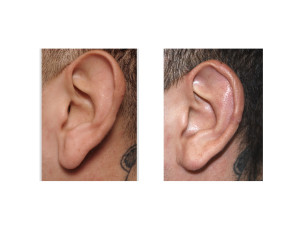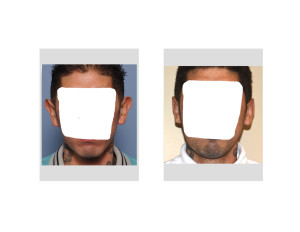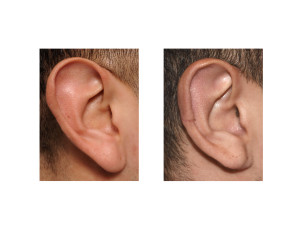Background: The most common aesthetic ear procedure is that of ear pinning. Known technically as otoplasty, the protruding ear is reshaped and sutured (pinned) back so that it aligns better with the side of the head. This traditional aesthetic ear procedure relies on cartilage manipulation/folding rather than actual tissue removal. Its effects are created by reshaping the deformities in the existing ear cartilage.
Macrotia or the large ear is a very different surgery from that of the more common protruding ear. It is a problem caused by tissue excess having an exaggerated vertical height to the ear. The traditional vertical ear height is around 60mms with slightly more being acceptable for men and slightly less for women. When the vertical ear height exceeds 70mms it is always seen as too big or too long.
Macrotia surgery, unlike setback otoplasty, requires tissue removal. From the bottom of the ear, the earlobe can be vertically reduced by wedge excision. The top of the ear is more challenging as it is composed of cartilage and there is no place to completely hide the reduction incisions.
Case Study: This 25 year-old male had long been bothered by his large ears. They had vertical measurements of 756mm from the height of the superior helix to the bottom of the earlobe. There was also excessive protrusion of the upper ear from the side of the head.


Highlights:
1) Reduction of a large ear (macrotia) is quite a different surgery than that of traditional ear pinning or otoplasty.
2) Vertical ear reduction requires reduction of the ear as well as tat of the bottom of the ear.(earlobe)
3) The scars from vertical ear reduction are minor with the most visible one crossing the ear at the central helix.
Dr. Barry Eppley
Indianapolis, Indiana
Plastic Surgery Case Study – Macrotia Reduction for Vertically Long Ears
Top Articles
-
Clinical Outcomes in Rib Removal Surgery for Waistline Reduction
Rib removal surgery represents the elimination of the last anatomic...
-
The Surgical Technique of Clavicular Osteotomies in Shoulder Width Reduction
Shoulder width reduction is done by shortening the length of the...
-
Masculinizing the Male Forehead with Custom Brow Bone Implants
The shape and appearance of the forehead is highly influenced by...
-
Case Study: Lengthening of the Nose with a Rib Graft Rhinoplasty
Background: The evolution of rhinoplasty surgery over the past twenty years...
Top Articles
-
Clinical Outcomes in Rib Removal Surgery for Waistline Reduction
Rib removal surgery represents the elimination of the last anatomic...
-
The Surgical Technique of Clavicular Osteotomies in Shoulder Width Reduction
Shoulder width reduction is done by shortening the length of the...
-
Masculinizing the Male Forehead with Custom Brow Bone Implants
The shape and appearance of the forehead is highly influenced by...
-
Case Study: Lengthening of the Nose with a Rib Graft Rhinoplasty
Background: The evolution of rhinoplasty surgery over the past twenty years...



